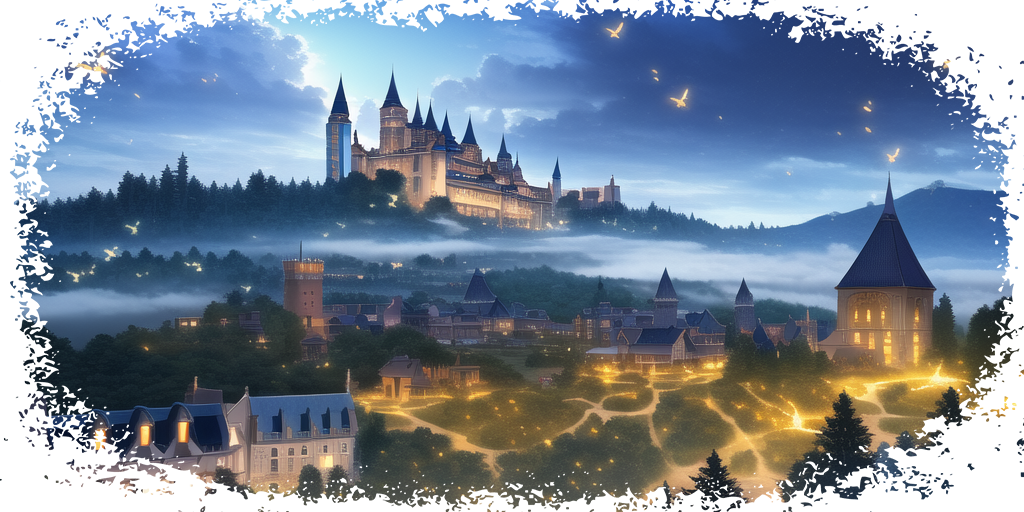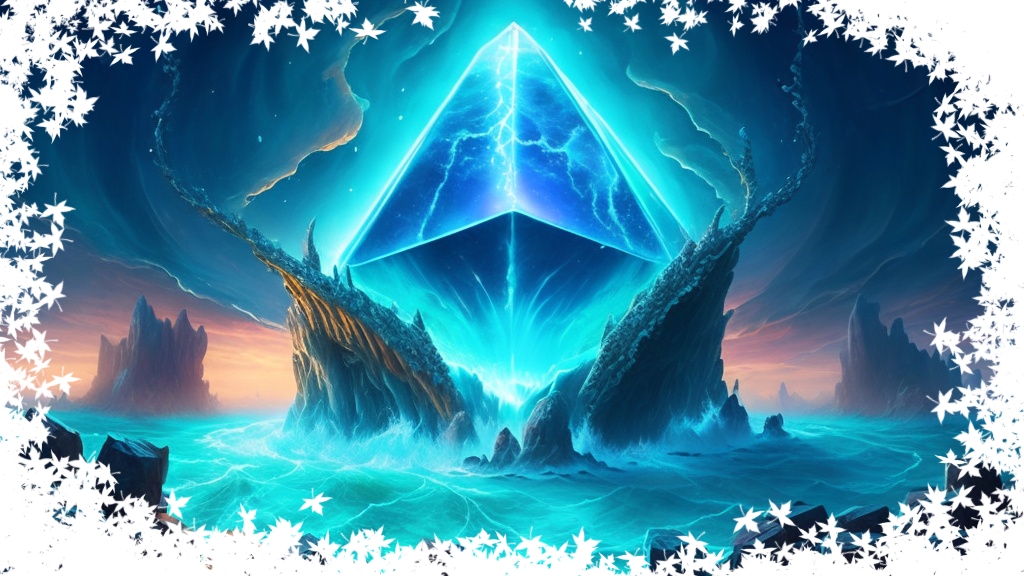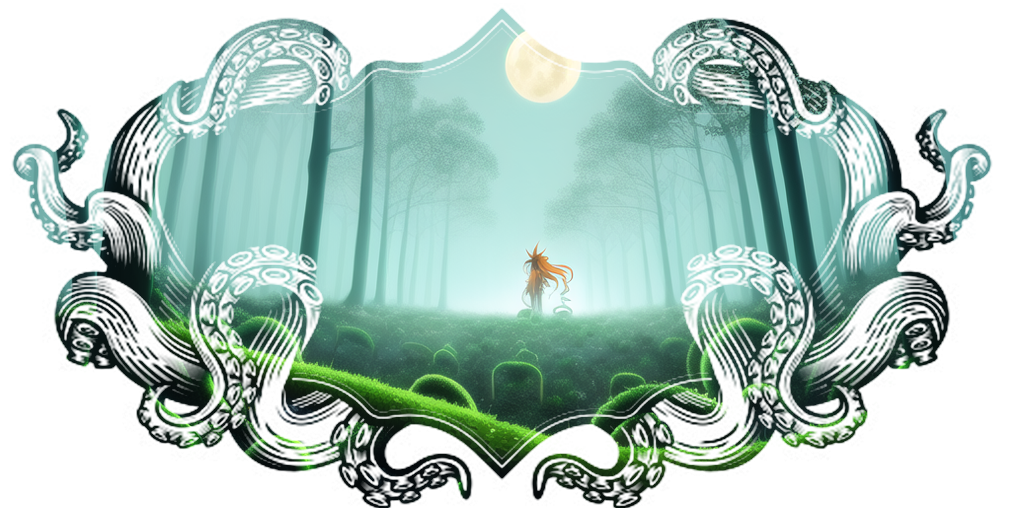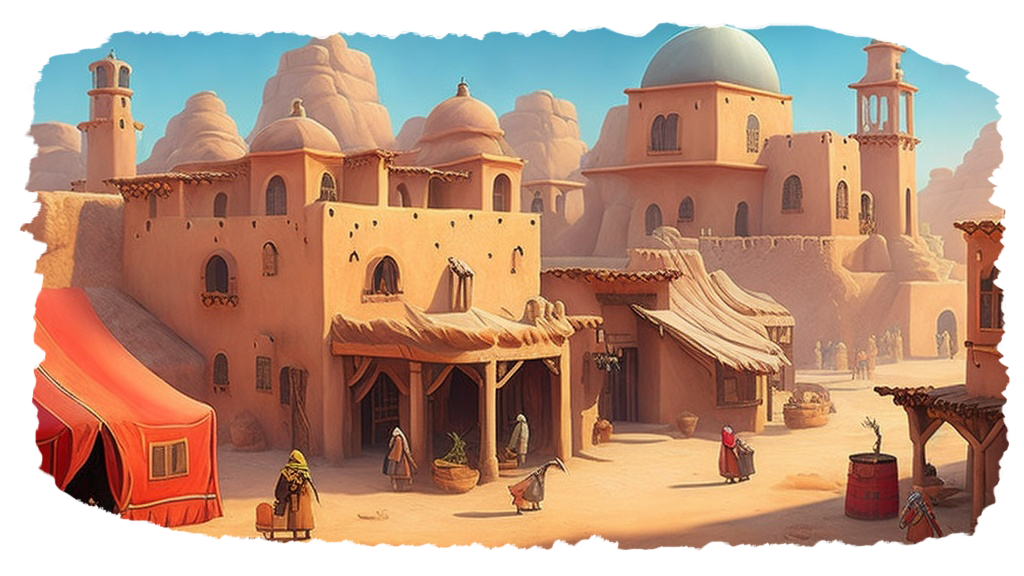
The World
Everyone knows the world is flat. Or, more precisely, it’s in a shape of concave disc held firmly by the hand of goddess Vaira, who uses it as a goblet for drinking water.
Or at least that’s what the legends say. How true is it? The only ones that know for sure are the adventurers who got carried by The Flow and fell down into the abyss. And they’re not able to tell tales.
GEOGRAPHY: Kriterra
Northern Empire
The lands of the north are split in two by the Great Basin river, which originates as a tributary of the Flow in northern Kriterra and then flows into the Great Basin near the center of the continent. The Great Basin river is the lifeblood of the empire, with the Imperial Capital straddling it near the mouth of the flow and almost every major city in the northern Empire situated near the river or one of its tributaries. The northern side of the river tends to be more rugged and hilly terrain with grasslands roamed by grazing herds of sheep, though the occasional wind-sheltered valley supports a larger city here and there. To the south the gentler terrain supports woodlands and large farming communities. Closer to central Kriterra rises Mount Aria, which blocks access to the shores of the Flow until one passes through to the forests of the south.
Southern Empire
The southern provinces of the Empire are viewed by some as a ‘backwater’. In truth, much of these lands are all but uninhabited. A few cities dot the shores of the Flow, and there are High Elf villages scattered around the forests, but the majority of Kriterran citizenry avoid the area. What few settlers try to develop the lands often end up vanishing for one reason or another. The forests are rife with bandits and local forces are only able to patrol in the immediate vicinity of the cities and major trade routes. There are also tales, as far fetched as they might be, that the woods are haunted, and the trees themselves rebuke any who attempt to clear land in the south.
Academy
Situated in the center of Kriterra, near the Great Basin lake, is the Academy of Kriterra. The school is situated on a hill on the northwest side of the lake, with forests to the south, the Great Basin River to the east, and rolling hills to the north. The nearest city is upriver from the Academy about a week’s journey on foot. This is in part due to the thought that, if anything were to go wrong at the Academy, it would be safely isolated from major population centers.This has lead to a sort of ‘academy village’ springing up around the school itself, however, to cater to various needs the students and teachers might have.
GEOGRAPHY: Apteros
Al-Nhamli
The Great Desert of Al-Nhamli is the largest single geographic feature in all of Apteros, made up primarily of shifting sand dunes gradually moving eastward with the winds blown in from the Flow. The sand itself is deposited by the Flow on Al-Nhamli’s western shores, the ebb and flow of the great river depositing new sediment daily. The city of Nham is situated on a small plateau and built around an oasis in the desert, a rare stable water source in Al-Nhamli, though the city’s growth has required the people of Nham to import fresh water from the coast through a network of trading villages. To the south the desert slowly shifts into savannah and scrubland as it transitions into the Steel Plains, whereas the northern side of the desert is full of rugged hills leading into the steep mountains of Hellgate.
Steel Plains
While the Steel Plains support more life than the Great Desert, they’re no less harsh an environment. The plains are mostly flat and dry, with tall grasses that make up the majority of the savannah. The plains are named for the so-called ‘Steelgrass’ that covers most of it, a hardy species of grass which can grow to the height of a man. The edges of these blades of grass are quite sharp and lined with barbs to dissuade herbivores from eating it. When Kriterran explorers first traveled the plains there were several instances of the men getting nasty cuts from the plants and thus their name was coined. These plains are grazed by herd animals such as antelope that migrate across the region seeking fresh water and plant life more amenable to being eaten. On the eastern edge of the plains the savannah gives way to light forest, marking the border of the Deepwoods. Farther to the south are the cliffs of Vaira’s Bowl.
Deepwoods
Southeastern Apteros is dominated by the deepwoods, a great forest of ancient trees that scrape the sky and create a canopy so thick that the forest floor is shrouded in darkness even during the brightest days. The Deepwood is struck by rainstorms regularly, allowing life to thrive in the region and the forests are home to uncountable species of animals adapted to the unique environment. The forest, like much of Apteros, is a good deal warmer than Kriterra. Where Al-Nhamli and the Steel Plains are dry and devoid of moisture, however, the Deepwoods are steeped in humidity. It is little wonder, then, that the majority of those who live there wear little if any clothing most of the time. Many goods traded in Kriterra are sourced, originally, from the Deepwoods, such as coffee and cocoa beans. A river branching off from the Flow reaches around the border between desert and Deepwoods before cascading off the edge of the Bowl to the east. This river is in Brighthearth territory, the Zev tribe most open to outsiders, and they maintain trade posts with both Nham and Kriterra on the river banks.
Hellgate
Even amongst the extreme conditions of Apteros, Hellgate is harsh beyond imagining. Originally known as the Dragonmaw Peaks, the mountainous north of Apteros was frigid and home to only the hardiest plants and animals, such as the mighty dragons. However, when the portal between Vaira and Hyirzm was opened, the subsequent cascade of mana to the region caused volcanic eruptions and lightning storms that swept the area. The mountains are now either bitterly cold or insufferably hot, depending on where one is looking, and regular lava flows and ash storms make travel in the area dangerous. There are still some stable routes through the mountains travelled either by the demons themselves, or the few brave merchants willing to peddle their wares to the natives of Hyirzm.
HEART OF VAIRA
The middle of the disc is dominated by the mana crystal, its name varies from culture to culture, but people from Kriterra refer to it as the Heart of Vaira. It’s the source of magic power for the land, affecting both flora and fauna in unpredictable ways. The closer to the crystal, the more pronounced the effects are, but also more corrupted. Many animals close to the mana crystal were turned into monsters. Plants nearby are aggresive and grow out of control. Many wizards tried to directly harness the power of the mana, but declined into insanity.
NATIONS AND POLITICS
The Empire of Kriterra
Kriterran history is a fickle thing. Few records exist from before the founding of the empire due to a great calamity that struck the western continent, leaving much of the region’s history unclear, and open to interpretation. What can be agreed upon is that roughly 1200 years ago some event happened that all but wiped out ‘Old Kriterra’. 800 years ago the Empire of Kriterra was founded. Records from the time state that a council of kings were convened under the auspices of the Kingdom of Eliorecia, an Elven state on the southern shore of the Great Basin River. This council was called to put an end to the incessant territorial wars between the kingdoms founded since the collapse of Old Kriterra. The documents describe, in detail, the great wisdom of King Elorant the Third for attempting to head off another great conflict that could scourge the continent a second time.
The summit resulted in the creation of the Council of Kings, precursor to the Empire itself, formed out of several small kingdoms near Eliorecia. There were, however, kingdoms that refused to see Elorant’s wisdom. The document goes into great detail about just how foolish and shortsighted the leaders of these nations were as well. While ostensibly a council created to avoid a war, the next century of Kriterran history dealt with the subjugation of these reticent kingdoms until, eventually, all of the Kriterran continent was unified. The Elves of the Forest Kingdom of Thelia would refuse to the last. Rather than be wiped out, many citizens of Thelia would escape into the dense forest and build small villages out of the reach of the Council, eventually becoming what are known today as ‘High Elves.’ The Council, having finished unifying the continent, would change its name to the Empire of Kriterra, posthumously naming Elorant as the first Emperor of Kriterra.
The Empire of Kriterra’s constitution was created the same day: An emperor would be elected by the council of kings to rule the nation and lead the council itself. The emperor is the greatest individual authority in the nation, but the council as a group can depose him if necessary. The first Emperor was an elf but the second to be elected was human. Ostensibly this was to show that the fledgling Empire was one of both men and elves, however it was more likely that this nomination was due to the balance of power within the council changing after Elorant’s death in battle.
The Empire in modern days is a relatively cosmopolitan state, with most cities having a mix of various races, though the majority of the population is primarily human and elven, especially among the upper classes. While racial tensions flare up from time to time there is, ostensibly, a policy to treat any citizen of the Empire as equal, regardless of their origin.
Due to Kriterra’s size there are many regional differences within the empire, and each individual city has its own culture to some extent. The southern reaches of the continent, for example, are difficult to live in and the small cities that dot the coast are populated by hardened, pragmatic people. The capital, by contrast, is dominated by unspoken social rules about how one should dress, talk, and present themselves in public where one could easily ostracize themselves socially without even realizing it.
Slavery in the Empire
While ‘slavery’, in particular, is illegal within the Kriterran empire, there are various legal loopholes that have been exploited by wealthy merchants to further line their pockets. For example when one person is indebted to another it is allowed for the debtor to work as an indentured servant, provided they are given room and board, to pay off their debts. Cunning merchants will thus rope gullible individuals into signing contracts with clauses charging them exorbitant fees so as to put them into debt slavery. Such ‘slaves’ can be transferred from individual to individual by purchasing their debt. The tactic has been very effective with Zev tribespeople who aren’t accustomed to such trickery being offered passage to Kriterra only to find their exorbitant transport fees essentially mean they’ll be working off their debts for life.
The Academy
The Academy of Kriterra was founded a century after the Empire itself was, created as a place to collect the esoteric knowledge of magic from across the Empire, as well as to act as a policing body for mages and ensure dangerous spellcraft is kept in check.
The Academy is, thus, almost a nation into itself, with its own laws and social norms. While ostensibly a school for magic alone, the Academy is also the greatest center of learning in all of the Empire and nobles from across Kriterra have their children apply to the entrance exam for admittance. It is considered very prestigious for an heir to be a graduate of the Academy, even if it is just for the ‘general education’ programs that lack any magical training.
The Academy is located in central Kriterra, built on the shore of the Great Basin and nearby Mount Aria. To the Academy’s west is the so called ‘Slimy Forest’, which has been acting as a disposal ground for magical experiments for centuries. This forest also acts as the first step into the elven woods of southern Kriterra.
The Academy itself is a school campus the size of a city, having been expanded many times over the years. While the Academy is ostensibly located so far from other cities for the sake of isolation and safety, it hasn’t stopped a town from springing up around the Academy’s grounds to provide secondary services to students and staff, such as bakeries and clothing shops. The campus is split into sections with their own dormitories and classrooms, keeping the general studies and magical studies students largely isolated from each other.
While the general studies students are primarily from the nobility of Kriterra, the application to magical studies courses is much more rigorous. A prospective student must demonstrate a certain degree of magical proficiency and potential for development to be considered as a candidate. These entrance tests are performed in two steps: First a student typically sends in an application and, as part of it, must apply an enchantment to the parchment itself to prove basic competency. Should this application be accepted, an examiner will meet the applicant in person and put them through thorough testing to determine whether they would be a good fit for the Academy.
Due to this rigorous process most cities have their own minor schools of magic, or magic tutors, willing to sell their services to those who have failed the entrance exam or, perhaps, wish to practice in advance for better chances of entry.
The teachers of the Academy are no less strictly tested, with most being considered masters of their prospective field. The current headmaster, Shay, for example, is considered the world’s foremost expert on evocation magic.
Nham
The desert city of Nham is the largest city in all of Vaira, which is especially impressive when one considers the harsh landscape around the city walls. However, the city has been built up over millenia into the international trading hub it exists as today. Unlike Kriterran history, the history of Nham is well kept and recorded both in city records as well as in the ledgers of merchants.
Nham was originally a small settlement founded around an oasis atop a stable plateau in the ever-shifting sands of the Al-Nhamli desert. This settlement was named after the Nham tribe who dwelled there. Unlike most Dunesmen tribes, they stayed in one place, rather than migrating across the desert in search of water and food or ‘walking with the rain’ as their people call it. Due to the nature of Dunesmen tribes, the settlement would likely have stayed a small tribal village for centuries if not for the sudden influx of human settlers on the shores of Al-Nhamli.
These human refugees from Kriterra had managed to survive the journey across the Flow. Luckily for them, the Dunesmen’s particular customs regarding hospitality and co-prosperity meant they didn’t have to face the hulking lizardmen in battle, and instead were taught ways to survive in the desert. While some of these human refugees went on to create their own nomadic tribes or integrate into existing Dunesmen ones, many of them made their way to Nham. The oasis was large enough to support the growing community with water, but food was still scarce. The human settlers, however, had knowledge of farming that the Dunesmen lacked. Soon irrigation channels were built and this farming community would support the new population.
As Nham grew it would require more water and some of this was provided by the construction of a great aqueduct to redirect meltwater from the nearby Dragonmaw Peaks to Nham. With the city growing larger both from the human population growing as well as more Dunesmen tribes moving into the city, it would expand in a series of rings, eventually taking up the entire plateau. The Dunesmen customs encouraged trade between nomad groups and, despite the growth of the city, violent crime was surprisingly rare. Perhaps it was the heat of the desert discouraging wasted energy, or perhaps it was the Dunesmen customs rubbing off on the human residents, but disputes were, and still are, typically settled via bartering or ritual.
For there was always one accepted form of conflict in Dunesmen culture: The Feast of Blood. The Feast is a form of ritual combat, sometimes to first blood, and sometimes to death, where Dunesmen would settle disputes too great for words, or simply to earn favor with potential mates. This yearly festival of sex and violence takes place during the Dunesmen’s mating cycle, where males becomes irritable and aggressive and females are, well, horny. Those who are weak of arm but possess great wealth can hire other males to fight on their behalf, and either strength of arm or strength of wallet are considered to be great indicators of a good mate for prospective females.
This custom has been integrated into the mixed culture of Nham, with The Feast of Blood being an annual gladiatorial battle in the city’s colosseum. However, since humans and other species living in Nham might have greater difficulty restraining their violent urges from day to day, there are smaller battles going on almost daily. Sometimes these battles are sponsored by the current Sultana as spectator events between seasoned warriors, and other times they are simply a way to settle disputes between shopkeepers. The stakes of the battles vary greatly, but the most intense events are always reserved for the yearly Feast.
Because of the eclectic mix of cultures in Nham, there have been other changes to the custom of ritual combat. For example, it is considered an act of weakness to intentionally try and kill your opponent in battle. While deaths do occasionally occur, it’s the exception, rather than the rule. The colosseum holds great importance to the Royal Family, as well.
The ruler of Nham is always a Sultana. She does not marry, as she is considered to be the mother to her people. Instead, the royal lineage is continued by choosing a consort from amongst the warriors of the Feast, usually the winner of the contest. The consort holds as much authority as the Sultana decides to place in them, but whether the Sultana holds them in high esteem and treats them as their right hand, or whether they are only given one night with her, it is always considered a great honor to be chosen. This methodology of continuing the royal lineage has led to a royal family that supposedly shares the blood of every race on Vaira.
Because of the association with sex that has long been a part of the Feast it isn’t unusual for conflicts between warriors of the opposite gender in the arena to break down into fucking directly on the sands of the arena themselves, especially amongst the Zev tribes who send their young warriors to the colosseum to prove themselves. Since these ‘battles’ often prove even more popular than the ones that shed blood, it’s simply considered a form of ‘grappling’, and is allowed to go on until one party is unconscious or surrenders.
Hellgate
Hellgate refers to the outpost built up around the rift between the world of Vaira and Hyirzm, the homeland of the Dypal, or the ‘demons’, as they are commonly referred to across Vaira. Outsiders know very little of the world of Hyirzm, as the mana concentration is so high that should any native of Vaira try to cross its threshold they would almost certainly succumb to mana corruption. Thus, what knowledge exists is only that which demonkind has deigned to share.
The world of Dypal is unlike that of Vaira, there exists only one, great landmass floating above an endless sea of clouds. There are only a few varieties of plants and animals, likely due to the lack of competition for resources, as the mana which suffuses the world provides the majority of the nourishment the beings who live there require. The Dypal are the only sentient race of their world, and all Dypal are citizens of the same kingdom, with the Demon Lord at the head of its dynasty.
The capital city of this kingdom is apparently majestic and massive in scope beyond any of the cities of Vaira, though no scholars native to Vaira would ever be able to see it and document it except, perhaps, the dwarves, if they deigned to take interest.
Most of Vairan history with demonkind was that of war, specifically between the desert people of Nham and demonkind when the Hellgate first tore open. The world of Vaira is vastly different to their own, and the consumption of mana local to our world is both necessary for the Dypal to avoid starving while in Vaira, as well as a sort of euphoric pleasure to most Dypal. This mana ingestion can take the form of food, mana crystals, or even directly siphoning the mana from other living beings.
This is why, under the orders of the previous Demon Lord, the Dypal were organized for war and marched out of the Dragonmaw Peaks and into Al-nhamli. Centuries of war would follow, with skirmishes off and on where, were the demon armies ever to prevail in battle, horror stories of whole clans abducted and dragged to the north, or the bodies of the dead feasted upon after battle, would spread. When the Kriterran empire crossed the Flow and found their lost cousins living in Nham, they would soon realize the existential crisis demonkind posed to all of Vaira and join the war.
The last major battle of the war for Hellgate was a century ago, ending in the death of the former Demon Lord. The Dypal retreated north and were not heard from for nearly a decade. When they returned it was not with violence, but with envoys. The new ruler of Hyirzm declared that he did not wish to follow the path of his father, and explained that the first of his kind who arrived in Vaira were addled with the sights and sounds of the new world, all but driven to madness and insatiable hunger. Having adapted and learned, he would offer a hand in peace instead.
While the city of Nham has never formally accepted the peace treaty, citing atrocities of the past, the Kriterran Empire has since been in diplomatic talks with the people of Hyirzm. The concept of trade was, initially, a foreign one to the Dypal. Their world simply didn’t have any. The demons are born into their roles and, should the Demon Lord wish for something, it was brought to them. The idea of purchasing food, or other items, by exchanging goods was a unique novelty and the Demon Lord would have his advisors work tirelessly to determine what could be done to acquire a broader range of mana sources from Vaira, especially food.
Succubi were key to these efforts, serving as agents across Vaira. The succubi with their natural charm would spread across Vaira, either in disguise or by selling themselves as exotic slaves and servants. It was easy enough to acquire the mana they needed for sustenance from sex and, while out in the world, they would gather information. Whether it be as simple as the local cuisine they had tried or as complex as the racial factionalism in a given city, they would slowly relay this information back to Hyirzm.
The Demon Lord could thus build the first trading post between his people and the Vairans, situated near Hellgate, but far enough that the mana leakage would not harm the Vairan merchants. Rumors would be spread by succubi agents about this post where even simple things such as fruits and vegetables would fetch high prices and, before long, brave merchants would make the difficult journey there to peddle their wares.
This plan has met with great success, with Kriterran alchemists scrambling to buy even jars of dirt from Hyirzm thanks to its inherently high mana density. Even with Nham’s hostile stance towards demonkind, their marketplaces occasionally sell wares originating from Hellgate. Only a fool would pass up those kinds of profits in the desert city, after all.
Zev
The Plains
The Zev of the plains are split along family and tribal groups, with the dominant tribes of the Plains being the Steelfang, Sunfoot, and the Bloody Claw. Each of these major tribes controls large swaths of territory in the Steel Plains, with smaller, weaker tribes acting as tribal vassals, of a sort.
The Sunfoot control territory in the northern plains, near the border with the Al-Nhamli desert, and are the plains Zev most amenable to outsiders. While still fiercely territorial, the Sunfoot often send their young warriors to Nham to prove themselves in the colosseum, and are thus often encountered on friendlier terms than if one were to trespass on their territory. Nham regularly hires Sunfoot warriors as mercenaries and caravan guards in exchange for arms and armor, making the Sunfoot the best equipped of the three Great Tribes.
The Steelfang tribe is located in the central plains and is the largest of all the tribes. The Steelfang likewise control the largest number of vassal tribes. They often war with the Sunfoot and the Bloody Claw, but have thus far been unable to conquer either tribe thanks to the last member of the triad attacking Steelfang lands from the opposite direction, which keeps the balance between the three tribes, as both the Sunfoot and Bloody Claw know they would lose a direct, one on one confrontation.
The Bloody Claw are relatively isolationist, controlling the southern parts of the plains closer to the Deepwoods. The smallest of the three Great Tribes, the Bloody Claw makes up for their numbers with bloody-minded ferocity. While the Sunfoot often wear Nham-made armor and wield well-crafted weapons and the Steelfang have numbers and strength on their side, the Bloody Claw specialize in ambush and shock tactics, using the hillier scrubland of the south to their advantage.
All Zev tribes of the plains share a warrior culture that advocates strength and cunning as the greatest and most desirable traits. Weakness is to be abhorred, and uselessness to be despised. Thus, all adult Zev are expected to be able warriors with pregnant females and young children the only allowed exceptions. A Zev should not grow old and feeble, but die in glorious battle before that can ever happen.
Zev are also expected to find mates outside their own tribe, which is one motivator for the tribal warfare across the plains. Young warriors will go to battle with members of other tribes and, if they are victorious, may claim one or more as mates, though only strong potential mates would be desired. With adolescent warriors battling this way, it’s not unusual for a frantic melee to break down into an impromptu orgy before it ends, and the cultural fascination with both sex and violence, along with Zev’s naturally high sex drive, causes most plains Zev to become visibly aroused in battle and spend hours afterwards mating until exhaustion, a trait that has become quite popular in Nham’s colosseum events.
Zev tribes are led by a Tribal Chief. The Chief is expected to be the greatest warrior of their tribe, and the Chiefdom is rarely inherited. Instead, an aspiring warrior may challenge the current Chief to a ceremonial duel and, if victorious, will take their place. While the Zev expect women to fight, they do not allow women to become Chief, as if they become pregnant they will be unable to lead in battle.
The Deepwoods
The Zev tribes of the Deepwoods have developed a vastly different culture than their plains-dwelling kin. Historical records of Kriterran scholars considered them completely separate species for hundreds of years, and it is not difficult to see why. Forest Zev are, by and large, not confrontational people. Indeed, most of the tribes dotted across the forest have never even been seen by outsiders, their treetop villages well hidden from prying eyes. Many tribes are known only as names provided to scholars by the Brighthearth tribe.
The many tribes across the forest form a loose federation, with no direct leader or executive authority. Instead, in times of crisis, runners will be sent across the forest to meet with tribal elders and chiefs to form a council by which all the tribes of the forest can be directed towards a single purpose. This was, apparently, last performed when Kriterran ships landed on the shores of the Deepwood some two centuries ago.
Apart from these emergency meetings, the tribes generally rely upon eachother for trade and supplies, with different tribes specialized in providing food and goods to others in exchange for what they need in return. The Brighthearth serve as the only tribe that trades with the outside world, and thus is the point of contact for the entire Deepwood and any goods from outside of it that are needed.
Because of how important the Brighthearth has become in the centuries since their first contact with outsiders, it has grown to become the largest of the Deepwood Zev tribes. They are quite hospitable to visitors, and, with some knowledge from Kriterran architects, even created a great lift to ferry men and supplies from the shores of the World’s End up to Brighthearth, the treetop capital.
While the Brighthearth have ever refused to give much in the way of detail on other tribes for the sake of protecting their lands and privacy, they’re perfectly willing to speak of themselves and their own customs. The Brighthearth are led by a High Shaman. Candidates for this role must have very strong ties to their guardian spirits, and are often groomed for the role from birth, as it is the High Shaman who inspects every newborn Zev of the tribe to determine who their guardian spirit is.
These spirits are said to be the Zev’s own ancestors in animal form and all Zev are said to have one. However, only the Shamans are said to be close enough to their spirits to summon their aid directly. Indeed, the Zev seem to be predisposed to summoning magic, though it is unclear if these truly are the spirits of their ancestors or simply conjured creatures based upon their beliefs.
As a result of the increasing frequency of visitors from outside the Deepwoods, many young Zev from Brighthearth have begun to venture into the outside world, with Kriterra hosting the largest population of Zev immigrants.









